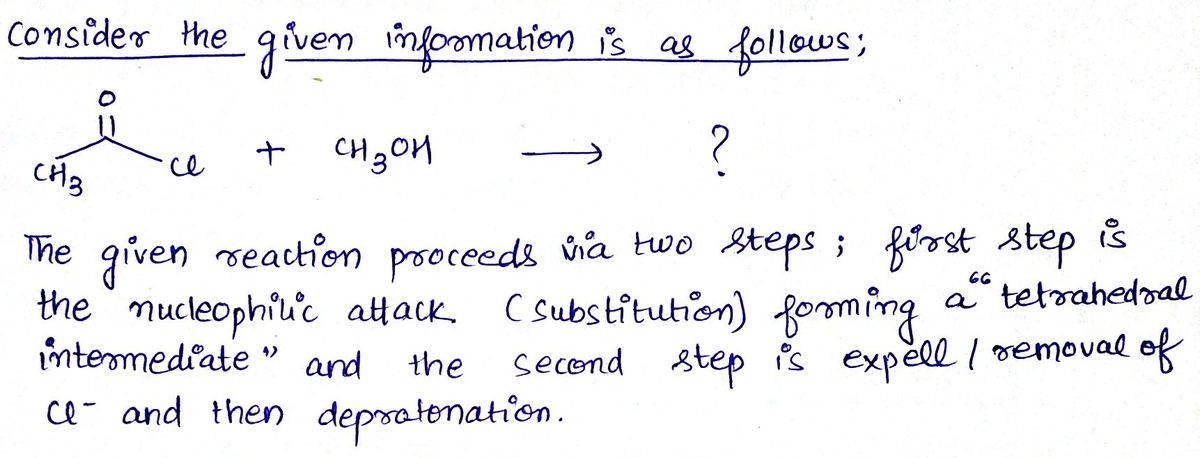Acyl transfer (nucleophilic substitution at carbonyl) reactions proceed in two stages via a "tetrahedral intermediate." Draw the tetrahedral intermediate as it is first formed in the following reaction. ● H3C You do not have to consider stereochemistry. . Include all valence lone pairs in your answer. ✪ CI . Do not include counter-ions, e.g., Na+, I, in your answer. . In cases where there is more than one answer, just draw one. IIA CH3OH / #[ ] در ?
Acyl transfer (nucleophilic substitution at carbonyl) reactions proceed in two stages via a "tetrahedral intermediate." Draw the tetrahedral intermediate as it is first formed in the following reaction. ● H3C You do not have to consider stereochemistry. . Include all valence lone pairs in your answer. ✪ CI . Do not include counter-ions, e.g., Na+, I, in your answer. . In cases where there is more than one answer, just draw one. IIA CH3OH / #[ ] در ?
Chemistry
10th Edition
ISBN:9781305957404
Author:Steven S. Zumdahl, Susan A. Zumdahl, Donald J. DeCoste
Publisher:Steven S. Zumdahl, Susan A. Zumdahl, Donald J. DeCoste
Chapter1: Chemical Foundations
Section: Chapter Questions
Problem 1RQ: Define and explain the differences between the following terms. a. law and theory b. theory and...
Related questions
Question

Transcribed Image Text:**Topic: Acyl Transfer Reactions and Tetrahedral Intermediates**
Acyl transfer reactions, a type of nucleophilic substitution at the carbonyl group, involve two stages facilitated by the formation of a "tetrahedral intermediate." In this exercise, you are tasked with drawing the tetrahedral intermediate as it first forms in the given reaction:
### Reaction:
- **Reactants:**
- Acyl chloride (CH₃C=OCl)
- Methanol (CH₃OH)
### Instructions:
- **Stereochemistry Consideration:**
- Not required for this drawing.
- **Valence Lone Pairs:**
- Ensure to include all valence lone pairs in your depiction.
- **Counter-Ions:**
- Do not consider counter-ions such as Na⁺ or I⁻ in your answer.
- **Multiple Answers:**
- If there are multiple possible answers, only one depiction is necessary.
**Toolbox:**
- A set of drawing tools is provided at the bottom, including options for adding atoms, bonds, lone pairs, and more.
This information and instructions aim to guide you in accurately depicting the transformation process involved in acyl transfer reactions.
Expert Solution
Step 1

Trending now
This is a popular solution!
Step by step
Solved in 2 steps with 2 images

Knowledge Booster
Learn more about
Need a deep-dive on the concept behind this application? Look no further. Learn more about this topic, chemistry and related others by exploring similar questions and additional content below.Recommended textbooks for you

Chemistry
Chemistry
ISBN:
9781305957404
Author:
Steven S. Zumdahl, Susan A. Zumdahl, Donald J. DeCoste
Publisher:
Cengage Learning

Chemistry
Chemistry
ISBN:
9781259911156
Author:
Raymond Chang Dr., Jason Overby Professor
Publisher:
McGraw-Hill Education

Principles of Instrumental Analysis
Chemistry
ISBN:
9781305577213
Author:
Douglas A. Skoog, F. James Holler, Stanley R. Crouch
Publisher:
Cengage Learning

Chemistry
Chemistry
ISBN:
9781305957404
Author:
Steven S. Zumdahl, Susan A. Zumdahl, Donald J. DeCoste
Publisher:
Cengage Learning

Chemistry
Chemistry
ISBN:
9781259911156
Author:
Raymond Chang Dr., Jason Overby Professor
Publisher:
McGraw-Hill Education

Principles of Instrumental Analysis
Chemistry
ISBN:
9781305577213
Author:
Douglas A. Skoog, F. James Holler, Stanley R. Crouch
Publisher:
Cengage Learning

Organic Chemistry
Chemistry
ISBN:
9780078021558
Author:
Janice Gorzynski Smith Dr.
Publisher:
McGraw-Hill Education

Chemistry: Principles and Reactions
Chemistry
ISBN:
9781305079373
Author:
William L. Masterton, Cecile N. Hurley
Publisher:
Cengage Learning

Elementary Principles of Chemical Processes, Bind…
Chemistry
ISBN:
9781118431221
Author:
Richard M. Felder, Ronald W. Rousseau, Lisa G. Bullard
Publisher:
WILEY